Way it was—a Jewish innocent strikes out
By Sheila Orysiek
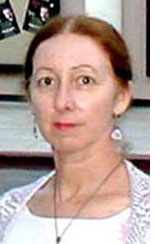 SAN DIEGO—Midway through my senior year in high school in Pennsylvania I found employment at a large insurance company as a member of a typing pool - it was three days a week after school and upon graduation became full time. I was told that should I prove competent it would transition into a position utilizing the full range of my secretarial skills.
SAN DIEGO—Midway through my senior year in high school in Pennsylvania I found employment at a large insurance company as a member of a typing pool - it was three days a week after school and upon graduation became full time. I was told that should I prove competent it would transition into a position utilizing the full range of my secretarial skills.
The typing pool was all female and consisted of ten typists, five checkers, and Helen, the department supervisor. We typed insurance policies, forms and endorsements which were received via a mail cart from the all male underwriting department.
The typing pool was strictly run. The typewriters each had a meter which counted key strokes. Blank forms were counted out to each typist. After the work was typed it went to a checker who read it for accuracy and typographical errors. If an error was found a report was filed against the typist. Keeping tabs of all this counting and checking was the task of the supervisor, Helen.
Every Friday afternoon all the typists were lined up along a wall according to the count of the meters on the typewriters. This lineup occurred in front of several departments; approximately 200 employees. Though I was a fast typist and a steady worker, I was always last.
Then we were lined up according to the number of typographical errors we had made that week. In a forty-hour week I usually made about five errors. That comes to one typographical error a day in eight hours of steady typing. This seemed rather a good pace to me, except in this area too, I was always last in the line up.
Though the other typists were at the supply cabinet as much as I, yet in this third category, too, I always did the poorest. I was never reprimanded nor threatened but it was humiliating to stand against the wall, obviously in last place for every one to see. In response I promised to work harder; I valued my job.
There was another problem. The all male underwriting department sat directly behind the typing pool across an open space - there were no private offices. It took the mail cart which brought the work from the underwriting department to the typing pool approximately three hours to make the circuit around the entire floor. Since the instructions to the typists were hand written by the underwriters it was not unusual for the typist to have difficulty reading the message. This was particularly true of one underwriter - Tommy. He was young, handsome and utterly unable to write legibly.
Whenever I couldn’t decipher his writing I asked the typist next to me and then Helen, our supervisor, but if they also could not read it, I attached a note to the work and put it on the mail cart addressed to Tommy. This meant a three hour interruption in the completion of this piece of work. Though I worked on other things in between, it was obviously not an efficient state of affairs to remove and then reinsert into the typewriter multiple carbon copies and try to line it all up again.
One day I glanced back over my shoulder and saw Tommy at his desk about ten feet away. Suddenly I just stood up, walked over and asked him to decipher his work for me. He did. I returned to my desk and finished the forms. It was a simple solution - but not to those around me. I was promptly called over to the supervisor’s desk and accused of “being after” Tommy. I tried to explain how much simpler it was to just walk over rather than wait three hours for a reply. The work would go so much faster and the carbon copies a lot cleaner.
The worthiness of my solution was not in doubt; but my motives were suspect. So I was barred from walking the ten feet to Tommy’s desk though this was in full open public view. This incident made me doubly anxious to elevate my poor performance as evidenced by the Friday lineup at which I was always dead last in every category.
After enduring this weekly humiliation for almost a year with no improvement in sight, I decided to look for a position that would use more of my secretarial skills and was fortunate to quickly find one as an executive secretary to an attorney. I was thrilled and gave my two weeks notice to Helen. She was not happy and told me how much she liked my work. I was dumbfounded. I told her this was surprising since I obviously was the worst typist in the department. She lowered her voice and explained what had been happening - that my being at the bottom in every category every week was no accident; it had been carefully planned by the other employees.
When I went to lunch the other typists held down the underline key on their machines so their meters would read higher than mine. When a checker found an error she would personally tell the other typists instead of filing a report. As for the blank forms, the supplier would “forget” to count them. Helen said that hiring a Jew was against company policy and that hiring me was an accident. But, I had turned out to be a good typist so instead of firing me; I was subjected to this weekly humiliation.
At 17 years old it had never entered my mind that this was the problem. My response each week had been to try harder. As Helen related this, she did not spare herself, but acknowledged that as the supervisor she had allowed it to happen. She then apologized and promised she would never condone this behavior toward another employee again.
On my final Friday I refused to join the lineup for my scheduled weekly humiliation. I went home eagerly looking forward to beginning my new job on Monday. On Sunday evening as I was assembling my brand new stenography tablets, pencils and pens and selecting a nice outfit for my first day on the job, the telephone rang. It was the attorney who was my new employer. He had called several times in the interim two weeks to keep in touch so this was not unusual. After talking to me a few minutes he said there was one thing he had neglected to ask.
His question was: “I forgot to ask if you are Jewish.” Being so young and still so innocent, and not wanting to deny it, I told him I was. He immediately answered that he could not consider having a Jewish employee and hung up. I was stunned. Fortunately because I lived with my parents I didn’t have to worry about food bills or mortgage payments.
Five years later when I came to San Diego and was looking for work I saw an ad in the newspaper that stated at the bottom “Minorities are strongly encouraged to apply.” Aha, I thought, at last, someone looking for me. I called and was asked to which minority group I claimed membership. I confidently told them, knowing that Jews are certainly a minority. Without hesitation I was informed that I was a member of the “wrong minority group.”
I am not sure how much, if at all, human nature has changed, but at least it is now illegal to ask a prospective employee to identify a religious affiliation. As a woman, I have a number of times been discriminated against because of my gender. On one of those occasions, after having invested in a large work appropriate maternity wardrobe, my employer told me (as he handed me a two week severance check) that he thought a pregnant woman was “unsightly.” This was a man who was an internationally known philanthropist as well as an ordained Rabbi.
Discrimination comes in all sizes, shapes and colors.
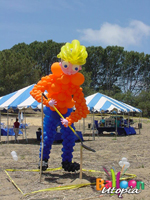 |
Balloon Utopia
Sandi Masori
619 339 8024
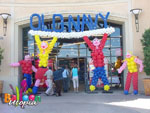 |
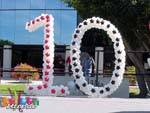
! |
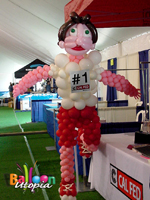 |



THE HISTORY MAN
Eilat: Both a historical and tourist gem
By Lloyd Levy
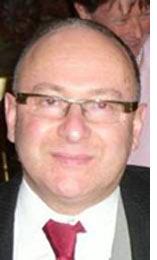 EILAT, Israel—Eilat at the very most southern tip of Israel, is my adopted second home. It’s open spaces, desert air, and wonderful climate, is a beneficial contrast to the overcrowding and bustle of London.
EILAT, Israel—Eilat at the very most southern tip of Israel, is my adopted second home. It’s open spaces, desert air, and wonderful climate, is a beneficial contrast to the overcrowding and bustle of London.
Originally Eilat was merely a former Turkish Police Post called Ummrashrash.
Eilat maintains the character of a frontier town. It was given to the Jewish State as part of the UN partition plan , and became part of Israel at Independence in 1948. However it was not physically occupied by Israel until 1949, so whereas Israel celebrates its 60th Anniversary this year, Eilat won't celebrate that important anniversary until next year.
The middel two photographs above show the transformation over the last 59 years There were not even any proper roads to the town until the mid 1950’s, and all food and water had to be brought in weekly by truck. The second picture shows Eilat now, with its population of 60,000. It’s hotels and vacation facilities are possibly the best in Israel.
The area is rich in history, being once part of the Roman Empire, and was even controlled by the Crusaders for a short while.
The most important site of Jewish interest in the area is Etzion-Gever, which was Solomon's port. Yet a great mystery surrounds the location of Etzion Gever, with various conflicting opinions as to the whereabouts of the actual site.
It says in the Bible (1 Kings 9:26-28) "Solomon made a navy of ships in Etzion-Gever, which is beside Eloth, on the shore of the Red Sea. " (1 Kings 22.48)- "Jehoshaphat made ships to go to Ophir for gold, but they went not, for the ships were broken at Ezion-Geber."
Solomon had a close alliance with King Hiram of Tyre, and Solomon’s navy was largely manned by Hiram’s Phoenician sailors.
In the 1930’s, the American archaeologist Nelson Glueck identified the ruins of Etzion Gever at a site called Tel-el-Khalifeh, which is exactly midway between modern day Eilat and Aqaba in Jordan. It is inaccessible nowadays, as it is right by the border fence in Jordan. The notion that this was the site of Solomon’s port is now largely discredited however. Many people, and certainly myself included, believe that Etzion Gever is really located at the site of a small island down the coast, called Pharoah’s Island (Coral Island is another name). Pharoah’s Island is a natural harbour, and the location and harbour remains are absolutely typical of Phoenician harbours of the period.
A photograph of Pharoah’s Island is above at right
Although Pharoah’s Island is nowadays in Egypt, it can be visited on a boat trip from Eilat.
For those readers who happen to be visiting Eilat in the next few weeks, I personally will be leading a historical tour around Eilat, on the Friday mornings of April 25 and May 2. The tour is 5 hours , is conducted in English, and does not go outside borders of Israel. We visit the remains of an ancient Arab Farm (1300 years old), a Roman Fort and Baths(1700 years old), a Neolithic cult site (8000 years old), and a Mamluk Bridge (500 years old).
If you want further details, please visit my web site at www.eilatpast.com


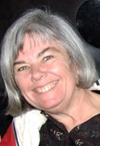
 Nancy Harrison
Nancy Harrison
cruise & tour specialist
(619) 265-0808
Not only better prices, but excellent, caring service!

ADVENTURES IN SAN DIEGO HISTORY
Editor's Note: Following are some stories from the Southwestern Jewish Press from 1947. If you have historical topics about the San Diego Jewish community you would like us to explore, please e-mail your suggestions to editor Don Harrison at sdheritage@cox.net
Family Reunited in San Diego
From Southwestern Jewish Press, January 9, 1947, page 3
The Streamliner that arrived Friday at 2:15 p.m. was awaited with more impatience than usual by some people, for it carried to San Diego the remaining members of the first family of displaced persons from Germany under the Truman directive.
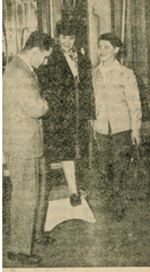 Shown {at right} are Mrs. Fanny Schauder and her son Jacob, aged 18, arriving to join their young son and brother Paul, also shown, who has been here for three months now. Originally hailing from Worms, Germany, the Schauders went to live in Mannheim, where the father engaged in business and the mother had bent to the serious task of bringing up her boys. With the advent of Hitler and the Nazi regime no plans of the Schauders could be adhered to. How the family existed for the past six years, and how the father lost his life at Buchenwald, and how the separated family was brought together again is a story in itself.
Shown {at right} are Mrs. Fanny Schauder and her son Jacob, aged 18, arriving to join their young son and brother Paul, also shown, who has been here for three months now. Originally hailing from Worms, Germany, the Schauders went to live in Mannheim, where the father engaged in business and the mother had bent to the serious task of bringing up her boys. With the advent of Hitler and the Nazi regime no plans of the Schauders could be adhered to. How the family existed for the past six years, and how the father lost his life at Buchenwald, and how the separated family was brought together again is a story in itself.
Now finally through the efforts of the United Jewish Fund and the Joint Distribution Committee the Schauder family has arrived in San Diego to make their future home here. What is their immediate reaction? How do they like the United states? What I their impression of this beautiful land that they just glimpsed through the windows of the train speeding them to their new home?
The shy, timid mother is hopeful for the future of her two handsome, smiling sons. They will finish their schooling first and perhaps even achieve the professions they had thought about in their native country. They boys speak English very well, already the mother knows a few words and is eager to study the language so that she can take part in every phase of community life here.
For our part, we welcome the Schauders to San Diego; they are the firs of six families that will eventually become permanent residents here; we know that bringing the Schauders here and being responsible for them is a small enough thing for our community to do.
Rabbi Rosenblum Takes Post
From Southwestern Jewish Press, March 27, 1947, page 5:
Rabbi Abraham L. Rosenblum, formerly of Salt Lake City has been selected to lead the Beth Jacob Congregation, the conservative Jewish group in San Diego. Arriving in this city last week, with his wife Esther and two sons, Murray Rubin, 7, and Sheldon Allyn, 3 ½ , Rabbi Rosenblum conducted his first service at the synagogue last Saturday morning. In a statement he said, “As a newcomer to the Jewish community of San Diego I wish to extend to you my sincere greetings and good wishes. I pray and hope to see more of you and to work together towards a brighter and hopeful Jewish future, locally, nationally and internationally. “The San Diego Jewish Community, as all Jewish communities throughout the nation, have a hard task before them; but if we stand shoulder to shoulder behind our local and national leaders to give them our material and aesthetic support, an undertaking can be accomplished.”
MR. Sandor Goldberger, president of the Congregation, which is located at 3206 Myrtle Street, stated that formal installation of Rabbi Rosenblum would be held some time in April, soon after the Passover holidays.
Beginning Friday evening, april 11th, Conservative services will be conducted by Rabbi Rosenblum each Friday evening, and there will also be services each Saturday morning.
Old Folks Celebrate Passover Seder in ‘Home’
From Southwestern Jewish Press, April 10, 1947, page 4
Places were laid for 54 guests at the first night Passover Seder at the San Diego Hebrew Home for the aged Friday night. Rabbi {Moshe} Bergman conducted the ritual with Joe Dembo and Sam Schissell assisting, and members of the home and their families participating. This is the third year that the old folk’s Home has been in existence and the sederem {sic, sederim} have special significance to the residents of the Home, particularly when they are able to have their children and their families at their side.
Two hundred guests attended the Seder at Temple Beth Israel. Rabbi Morton J. Cohn conducted the traditional service with the participation of temple members, their guests and their children. Many of the young guests sat at the head table with Rabbi and Mrs. {Sally} Cohn and assisted with the reading. Frankee Dee Hutler, 4, found the “Aphekomin” (hidden matzo) for which she was awarded a silver dollar by Rabbi Cohn. A number of servicemen were guests of the Sisterhood.
Many private sederum {sic, sederim} were conducted throughout the city. Mr.and Mrs. Al Neumann had twenty0nine guests at their seder this year. The Neumanns have had a seder in their home every Passover since 1913, and each year they have had approximately thirty guests at their table. Most of the uests have been attending for many years. The George Neumanns every year since the first seder; the Harry Tenebaums since 1918; the Robert Gordons for the past eighteen years. This year was a particularly joyus occasion for the Neumanns, as their son, Sidney, was able to join the family circle.
Mr. and Mrs. Louis Addleson also had twenty-nine at their family seder. Mr. and Mrs. George Shelley had nineteen members of the family with them. Seventeen guests attended the seder at the home of Mr. and Mrs. Reuben Fleischman and Mr. and Mrs. Abraham Abrahamson had the “holy number” thirteen at their table.
Mr. and Mrs. Irwin Fischer had fourteen at their home for the first night seder. Most of those attending were friends who {sic, whose} families are not in San Diego, and more {some words missing here} this seder brought home to the guests the traditional observance that they had previously shared with their relatives. Photographs were taken at the Seder, which they will send home.
At the fischer Seder were: Jacob Baranov. Mrs. Fischer’s father; Mr. and Mrs. Arnold Beinn; Mr. and Mrs. Leon Gold; Mr. and Mrs. Henry Goldy; Mr and Mrs. Morris Kattelman, Saul Gold, Lou Margolis, Mr. and Mrs. Fischer and their son, Bruce.

SAN DIEGO JEWISH WORLD THE WEEK IN REVIEW
Barry Jagoda in San Diego: Biblical scholar David Noel Freedman dies
Rabbi Baruch Lederman in San Diego: He flew literally on a wing and a prayer
Rabbi Dow Marmur in Jerusalem: Eric
Yoffie v. John Hagee: Round One
Marissa Palin in San Diego: And what of the women of Passover?
Ira Sharkansky in Jerusalem: Should Palestinians be rewarded for seven years of violence and intransigence?
Adventures in San Diego History: Today we feature stories from the immediate Post-World War II period.
Donald H. Harrison in San Diego: Stop trying to turn Obama into Foxman
Eran Lerman in Jerusalem: Gaza terrorists apparently want to make their own people absolutely miserable
Rabbi Dow Marmur in Jerusalem: Jews must recognize the new Poland
Sheila Orysiek in San Diego: Chapter Three in the serialization of her novel, Reluctant Martyr
Rabbi Leonard Rosenthal in San Diego: Ridding ourselves of spiritual chametz
Adventures in San Diego History: Stories of pre-World War II San Diego
Ulla Hadar in San Diego: A new correspondent introduces herself
Donald H. Harrison in San Diego: Mayor envisions Lindbergh-Rodriguez solution for future San Diego air travelers
Rabbi Dow Marmur in Jerusalem: Israeli news diet: peace, democracy, sex
Janet Tiger in San Diego: Salute to Rosentals goes tricultural
Adventures in San Diego History: We conclude our series of stories from 1922 in which members of San Diego's Jewish community looked at their past, present and future.Garry Fabian in Melbourne, Australia:
—Anti-Defamation Commission seeks race ban on hate literature on the web
—Jewish community deals with child abuse
—Jewish Musician receives top honour
—Jewish representation at summit
—Israel sparks union spat
—UN bid could hurt Israel
—Bialystock Comes back to life in 21st Century
Donald H. Harrison in Rancho San Diego, California: Searching for the 'Lost Tribes of Israel' at the Heritage of the Americas Museum
Sheila Orysiek in San Diego: Tales From My Garden:The Third Day...
Adventures in San Diego History: Members of San Diego's Jewish community in 1922 looked at their past, present and future. Our series continues.
J. Zel Lurie in Delray Beach, Florida: Israel again promises checkpoint removal
Rabbi Leonard Rosenthal in San Diego: Welcome strangers to our congregations
Ira Sharkansky in Jerusalem: Ultra-Orthodox face challenge of policing deviants and miscreants
Adventures in San Diego History: Members of San Diego's Jewish community in 1922 looked at their past, present and future.
Link to previous editions
< BACK TO TOP

 —
—